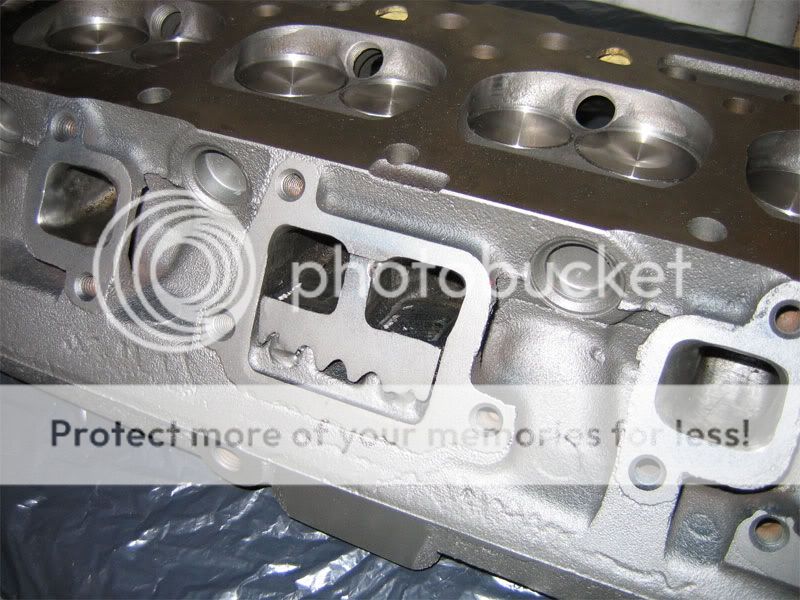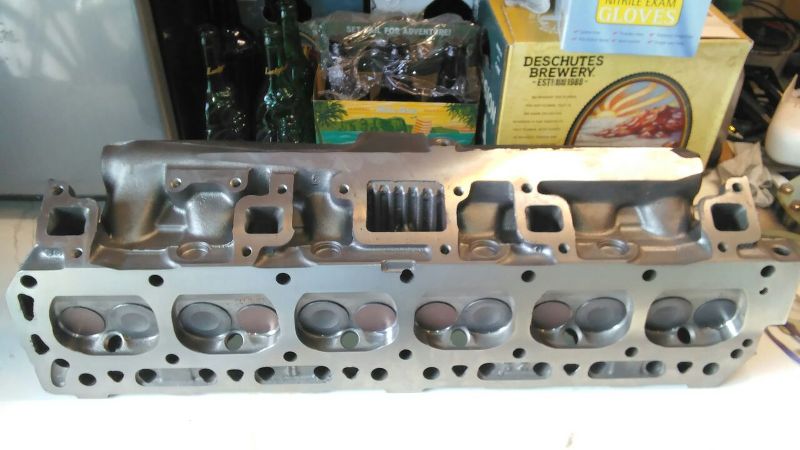So I finally finished the rough grinding on the combustion chambers on my C9 head. I didn't measure them before starting to grind but what I ended up with in the end was:
1) 61.5 cc <- has casting flaw that is a pit. Nothin I can really do about this.
2) 61 cc
3) 61 cc
4) 61 cc
5) 61 cc
6) 62 cc <- I got a little over ambitious and accidentally ground away some of the lip opposite of the spark plug
All-in-all, I'm pretty pleased. I'm not worried about the difference on #6. I plan on pushing my CR north of 9.5 which means the head milling will make this mistake disappear. Would mean I'm just left with the 0.5 cc difference on #1. I don't think I'm going to try to do anything to balance that out at all. Think it just is what it is.
I've done some math, using data from the handbook and elsewhere, and I plan on shaving 0.070". This should put me in the 45-46 cc range. I'm not doing any block work, so with the stock pistons and a 0.050" gasket, I should be somewhere around 9.7:1. If/when I ever do any block work, I'd bore it 0.020" over and couple that with the corteco gasket I'd be sitting right around 10:1 or so. I'm completely fine with running the high-test stuff at the pump since I don't really put that many miles on the ole girl. The only real snafu I could be looking at here is valve shrouding. I've read and re-read a number of the David Vizard books/articles and am fairly confident I know what to do in order to unshroud the new valves. I'll take a hit in CR but I think any loss there will be made up with increased breathing.
So what's next? I'm going to start working the pockets and the exhaust ports. I'm also talking to Does10s and getting the 110* split profile cam (264/274), STY springs, and oversized valves. I also plan on milling off the 1 bbl boss and migrating to a 2150 2 bbl. I intend to go with the 1.21 venturi, 350 cfm version. If it all goes as planned, I should have something fairly stout.
Other than the obvious need for a complete re-curve of the distributor, does anyone see any real glaring mistakes?
1) 61.5 cc <- has casting flaw that is a pit. Nothin I can really do about this.
2) 61 cc
3) 61 cc
4) 61 cc
5) 61 cc
6) 62 cc <- I got a little over ambitious and accidentally ground away some of the lip opposite of the spark plug
All-in-all, I'm pretty pleased. I'm not worried about the difference on #6. I plan on pushing my CR north of 9.5 which means the head milling will make this mistake disappear. Would mean I'm just left with the 0.5 cc difference on #1. I don't think I'm going to try to do anything to balance that out at all. Think it just is what it is.
I've done some math, using data from the handbook and elsewhere, and I plan on shaving 0.070". This should put me in the 45-46 cc range. I'm not doing any block work, so with the stock pistons and a 0.050" gasket, I should be somewhere around 9.7:1. If/when I ever do any block work, I'd bore it 0.020" over and couple that with the corteco gasket I'd be sitting right around 10:1 or so. I'm completely fine with running the high-test stuff at the pump since I don't really put that many miles on the ole girl. The only real snafu I could be looking at here is valve shrouding. I've read and re-read a number of the David Vizard books/articles and am fairly confident I know what to do in order to unshroud the new valves. I'll take a hit in CR but I think any loss there will be made up with increased breathing.
So what's next? I'm going to start working the pockets and the exhaust ports. I'm also talking to Does10s and getting the 110* split profile cam (264/274), STY springs, and oversized valves. I also plan on milling off the 1 bbl boss and migrating to a 2150 2 bbl. I intend to go with the 1.21 venturi, 350 cfm version. If it all goes as planned, I should have something fairly stout.
Other than the obvious need for a complete re-curve of the distributor, does anyone see any real glaring mistakes?




